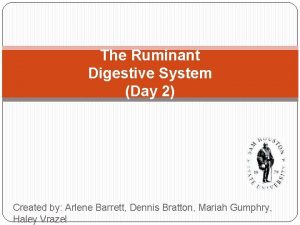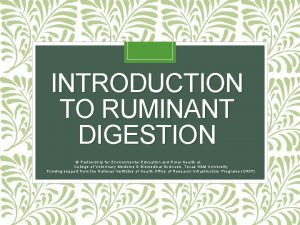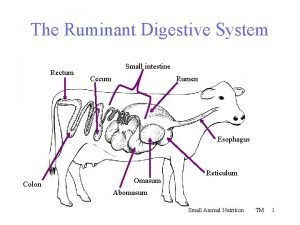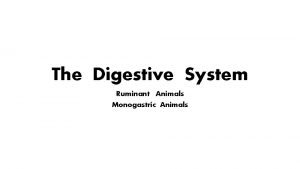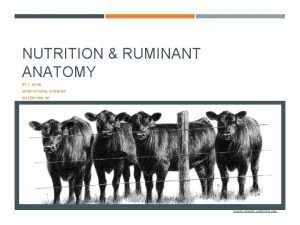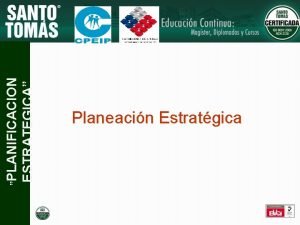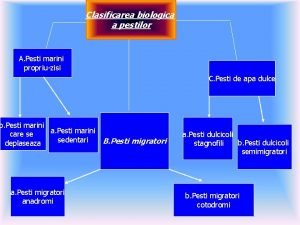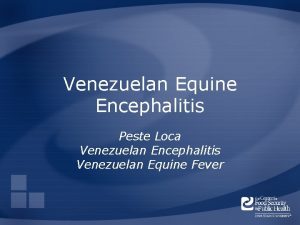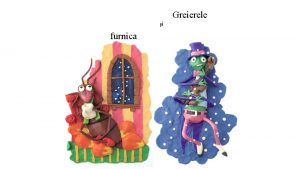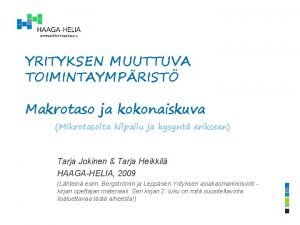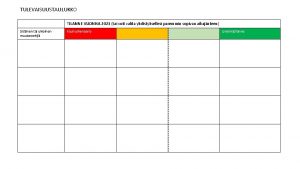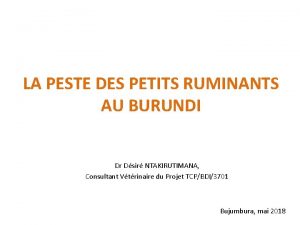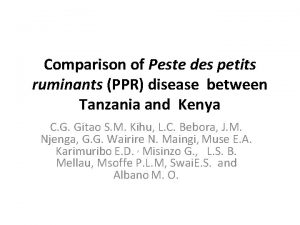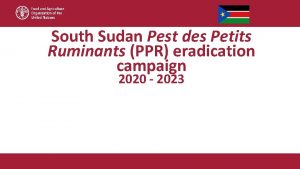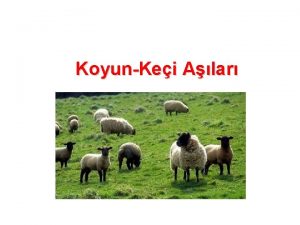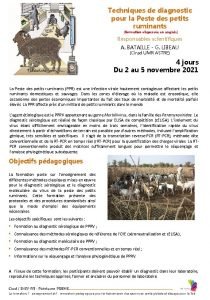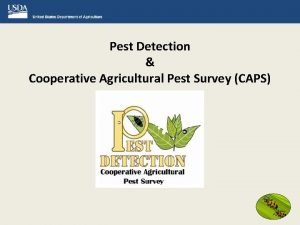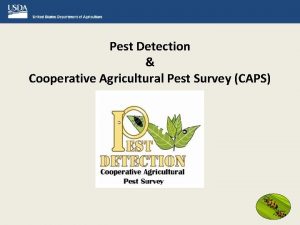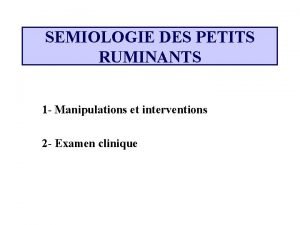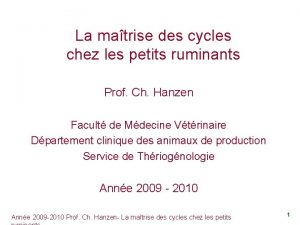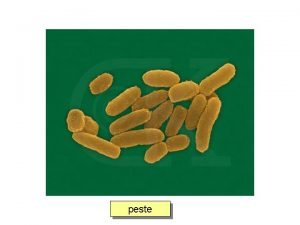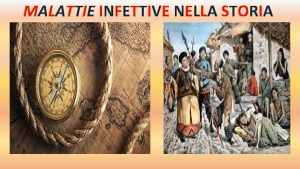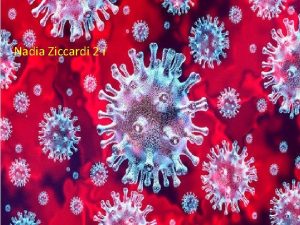Peste des Petits Ruminants Pest of Small Ruminants






























- Slides: 30

Peste des Petits Ruminants Pest of Small Ruminants, Pest of Sheep and Goats, Stomatitis-Pneumoenteritis Complex or Syndrome, Pseudorinderpest of Small Ruminants, Kata, Goat Plague, Contagious Pustular Stomatitis

Overview • Organism • Economic Impact • Epidemiology • Transmission • Clinical Signs • Diagnosis and Treatment • Prevention and Control • Actions to Take Center for Food Security and Public Health, Iowa State University, 2011

The Organism

The Organism • Family Paramyxoviridae • Genus Morbillivirus • Closely related to rinderpest virus – Very similar antigenically – Antibodies are cross-protective – Viruses are distinct Center for Food Security and Public Health, Iowa State University, 2011

Importance

History • 1942: Cote d’Ivoire in West Africa – Soon spread to Nigeria, Senegal, Ghana and • 1972: Sudan • 1990 s: Re-emerging as a result of decreases in veterinary services Center for Food Security and Public Health, Iowa State University, 2011

Economic Impact • Presence of disease can limit: – Trade and export – Import of new breeds – Development of intensive livestock production • Loss of animal protein for human consumption Center for Food Security and Public Health, Iowa State University, 2011

Epidemiology

Species Affected • Principally goats and sheep • Cattle and pigs seroconvert but do not develop or transmit disease • Wild ungulates can be affected – Gazelle, deer, ibex, gemsbok – Limited information on species susceptibility, occurrence of disease Center for Food Security and Public Health, Iowa State University, 2011

Geographic Distribution • Africa – South of the Sahara – North of the equator • Middle East • Parts of Asia – Indian subcontinent Center for Food Security and Public Health, Iowa State University, 2011

Morbidity and Mortality • Young animals most affected – Ages 2 months to 2 years • Varies by species, immunity, breed • Morbidity and mortality rates – Up to 100% in naïve herds – Lower in endemic areas • High case fatality rate – Exotic ungulates Center for Food Security and Public Health, Iowa State University, 2011

Transmission

Transmission • Close contact, inhalation • Virus shed in nasal and ocular secretions, saliva, urine, and feces • Long-term carriers unlikely • Role of fomites unclear – Do not remain infectious for long Center for Food Security and Public Health, Iowa State University, 2011

Disease in Animals

Clinical Signs • Incubation period – 2 to 10 days • Peracute • Acute – High fever – Serous nasal, ocular discharge becomes mucopurulent – Hyperemic gums, necrotic oral lesions Center for Food Security and Public Health, Iowa State University, 2011

Clinical Signs • Profuse diarrhea – Dehydration – Emaciation • Rapid respiration, dyspnea • Abortion • Skin nodules around muzzle • Subacute, asymptomatic disease Center for Food Security and Public Health, Iowa State University, 2011

Post Mortem Lesions • Inflammatory and necrotic lesions – Oral cavity – GI tract • Emaciation • Erosive lesions “zebra stripes” • Bronchopneumonia • Enlarged lymph nodes Center for Food Security and Public Health, Iowa State University, 2011

Sampling • Before collecting or sending any samples, the proper authorities should be contacted • Samples should only be sent under secure conditions and to authorized laboratories to prevent the spread of the disease Center for Food Security and Public Health, Iowa State University, 2011

Clinical Diagnosis • PPR should be considered in: – Sheep, goats, or gazelle – Acutely febrile, highly contagious disease – Oral or GI signs Center for Food Security and Public Health, Iowa State University, 2011

Differential Diagnosis • Rinderpest • Bluetongue • Contagious ecthyma • Foot and mouth disease • Heartwater • Coccidiosis • Mineral poisoning • Contagious caprine pleuropneumonia • Pasteurellosis Center for Food Security and Public Health, Iowa State University, 2011

Laboratory Diagnosis • Virus isolation • Antigen detection • RT-PCR • Serology • Samples – Discharges, oral lesions, whole blood Center for Food Security and Public Health, Iowa State University, 2011

Treatment • No specific treatment • Drugs to control bacterial and parasitic complications – May decrease mortality • Supportive care Center for Food Security and Public Health, Iowa State University, 2011

Disease in Humans are not affected

Prevention and Control

Recommended Actions • IMMEDIATELY notify authorities • Federal – Area Veterinarian in Charge (AVIC) http: //www. aphis. usda. gov/animal_health/area_offices/ • State – State veterinarian www. usaha. org/stateanimalhealthofficials. aspx • Quarantine Center for Food Security and Public Health, Iowa State University, 2011

Prevention and Control • Quarantine • Movement controls • Euthanasia of infected and exposed animals • Cleaning and disinfection of infected premises Center for Food Security and Public Health, Iowa State University, 2011

Vaccination • Outbreaks – Ring vaccination, high-risk populations • Endemic areas – Used to control disease • Vaccine types – Attenuated rinderpest vaccine – Homologous, attenuated PPR vaccine – Recombinant vaccine Center for Food Security and Public Health, Iowa State University, 2011

Disinfection • PPR virus killed by most common disinfectants – Alkalis (sodium carbonate, hydroxide) – Halogens (sodium hypochlorite) • 2% for 24 hours – Phenolic compounds – Citric Acid – Alcohols – Iodophores Center for Food Security and Public Health, Iowa State University, 2011

Additional Resources • World Organization for Animal Health (OIE) – www. oie. int • U. S. Department of Agriculture (USDA) – www. aphis. usda. gov • Center for Food Security and Public Health – www. cfsph. iastate. edu • USAHA Foreign Animal Diseases (“The Gray Book”) – http: //www. aphis. usda. gov/emergency_respon se/downloads/nahems/fad. pdf Center for Food Security and Public Health, Iowa State University, 2011

Acknowledgments Development of this presentation was funded by grants from the Centers for Disease Control and Prevention, the Iowa Homeland Security and Emergency Management Division, and the Iowa Department of Agriculture and Land Stewardship to the Center for Food Security and Public Health at Iowa State University. Authors: Jamie Snow, DVM, MPH; Katie Steneroden, DVM; Anna Rovid Spickler, DVM, Ph. D; Radford Davis, DVM, MPH Reviewers: Bindy Comito Sornsin, BA; Katie Spaulding, BS; Kerry Leedom Larson, DVM, MPH, Ph. D Center for Food Security and Public Health, Iowa State University, 2011
 Petit moineau chanson
Petit moineau chanson Trigonum petiti
Trigonum petiti Augustine lansot petits-enfants
Augustine lansot petits-enfants Des des des
Des des des Ruminant stomach
Ruminant stomach Digestion microbienne chez les ruminants
Digestion microbienne chez les ruminants Ruminant
Ruminant Cecum ruminant
Cecum ruminant Ruminant digestive system
Ruminant digestive system Monogastric pig
Monogastric pig Swine digestive system
Swine digestive system Ruminants
Ruminants Fortalezas de una persona
Fortalezas de una persona Mic si bun de gura sa-l opresti nu poti
Mic si bun de gura sa-l opresti nu poti Clasificare pesti
Clasificare pesti Peste negra
Peste negra Peste loca
Peste loca Dealuri zgribulite
Dealuri zgribulite Peste antonina
Peste antonina Historiku i kompjuterit
Historiku i kompjuterit Peste del norico
Peste del norico Historia e kompjuterit
Historia e kompjuterit Adunarea numerelor naturale 0-100 cu trecere peste ordin
Adunarea numerelor naturale 0-100 cu trecere peste ordin Peste analysis
Peste analysis Sorin peste
Sorin peste Peste antonina
Peste antonina Tema per projekt ne informatik
Tema per projekt ne informatik Kaupparekisterin toimialat
Kaupparekisterin toimialat Tulevaisuustaulukko
Tulevaisuustaulukko Peste varfuri de mihai eminescu
Peste varfuri de mihai eminescu Robin des bois des alpes
Robin des bois des alpes




